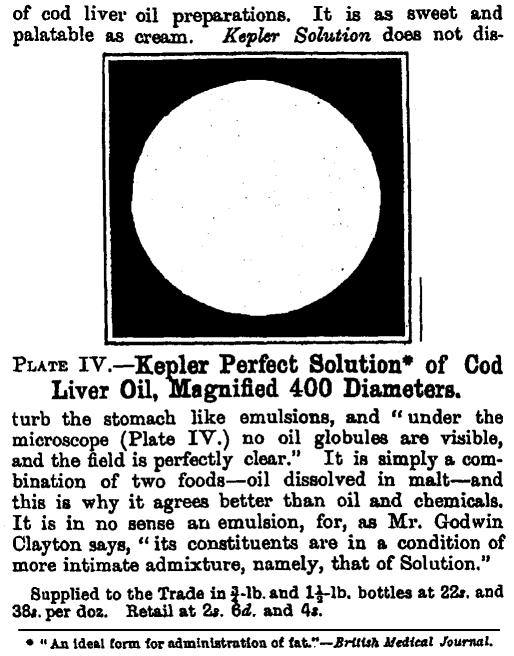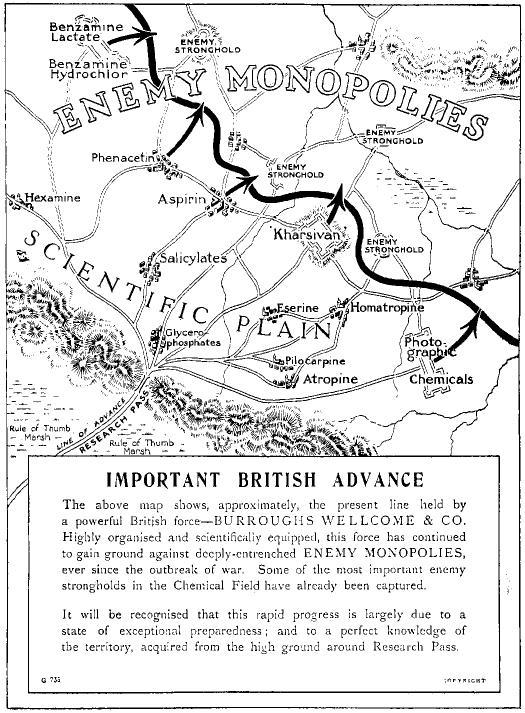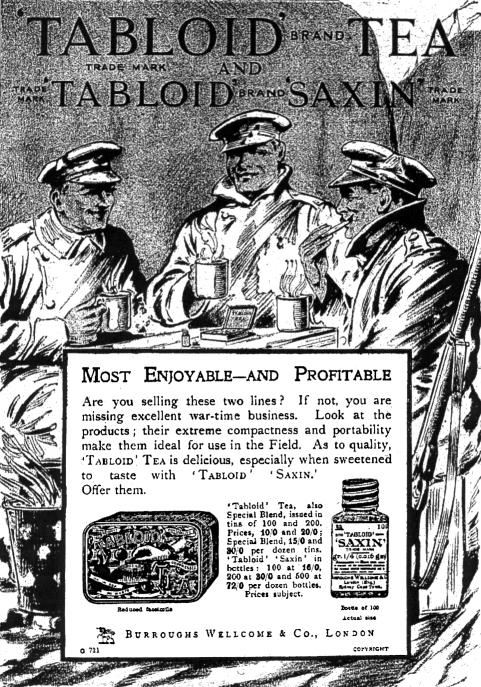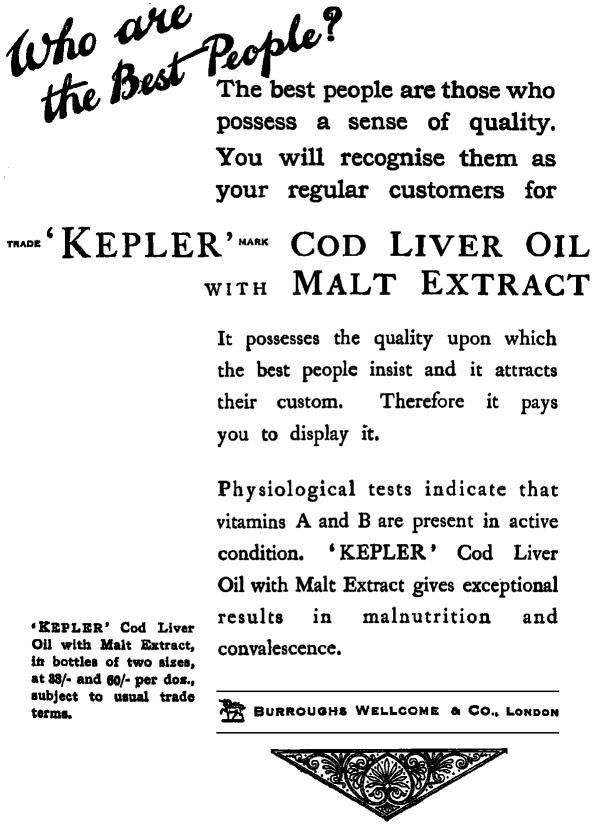Britain in the final decades of the nineteenth century was a vibrant market place for purveyors of medicines, including, inter alia, drug peddlars and travelling quacks, dispensing doctors and chemists, and established compounding companies such as Allen & Hanburys (est. 1715). Regulation and control of the manufacture, quality and efficacy of medicines were practically non-existent, and Weights and Measures and Poisons Acts were the principal relevant pieces of legislation.
During the same period, nationwide press and poster advertising, and the easier country-wide distribution of goods opened up by the railroads, contributed to the rise of the ‘branded’ commodity. Medicines, pills potions and nostrums were not exempt, and products such as Friar's Balsam, Wards Drop and Beechams Powders all achieved prominence and success in the second half of the nineteenth century. One such manufacturer, Thomas Holloway, was said to be spending £50 000 a year on advertising in 1883, the year of his death.
In Europe however, especially in Germany and Switzerland and to a lesser extent in France, several research-based scientific manufacturing companies were emerging. The rise of the dye industry in Germany, itself a byproduct of a coal-tar industry, provided a cadre of well qualified chemists whose scientific investigations of dye products led to the recognition of medicinal effects, and consequently to the creation of several pharmaceutical companies including Hoechst, Bayer, Sandoz and Ciba1. In Britain, the only company to engage seriously in such research activities was Burroughs, Wellcome & Co, founded in London in 1880 by two young American pharmacists.
ETHICAL PRODUCTS
It was an opportune time for Silas Mainville Burroughs and Henry Solomon Wellcome to establish a pharmaceutical business in Britain, initially importing innovative American products including compressed medicines, and exporting medical goods to Europe and the British Empire. From the beginning, extensive advertising and promotion in the pharmaceutical and medical press was an important part of their marketing strategy, although they were obsessively careful to avoid direct advertising to the public (which would have opened them, under the definitions of the Medicines Stamp Act, to the charge of being patent medicine suppliers). The young company intended to supply ethical products to the medical profession, and so had to avoid any dealings with quacks. In 1883 Burroughs, Wellcome & Co moved into one of the first commercial buildings in the City to be lighted entirely by electricity, and in the same year they established a manufactory in Wandsworth, South London, to produce ‘Kepler’ products—cod-liver oil and malt preparations. Because the Medicines Stamp Act classified imported medicines as patent medicines, they began to manufacture their own goods. Initially they marketed an electic range of products including shoe blacking, face cream, soda water, and pharmacists' books and apparatus, in addition to the compressed medicines of their former employers, McKesson and Robbins (Wellcome) and Wyeth (Burroughs). From the very beginning of their partnership, Kepler malt extract and Kepler cod-liver oil with malt were heavily promoted in journal advertising and by their travellers as nutritious, palatable foodstuffs ideal for enhancing, promoting and restoring strength, vigour and health. Gradually the company's portfolio became more defined: books, equipment and blacking disappeared from the lists, and a wider range of medicinal compounds was offered.
In 1884 Wellcome registered the trademark ‘Tabloid’ to denote some of their compressed products, although the word was never used exclusively for pharmaceutical preparations—tea, bandages and photographic chemicals being just some of the Tabloid products marketed. Kepler goods, however, continued to be very much to the fore: some advertisements reflected the company's scientific aspirations by the use of microscopic illustrations (Figure 1); others used attractive artwork to catch the eye and attention of doctors and pharmacists (Figure 2).
Figure 1.
Part of advertisement in Chemist & Druggist (supplement) 26 January, 1889
Figure 2.
Advertisement in Medical Press & Circular Advertiser 18 September, 1899
BIOLOGICAL THERAPIES
In 1895 Burroughs died unexpectedly after a short illness, and Wellcome became the proprietor of the company. Although disputes with Burroughs' widow caused some immediate difficulties, Wellcome's new economic security soon enabled him to indulge his wide interests more extensively and roubstly than previously. Inspired by his personal passion for the history of medicine—a subject he interpreted broadly—he collected books, manuscripts and artifacts, supervised archaeological excavations, and created medical museums and a large personal library2. Of more relevance to the development of his business, he also established research laboratories—the Wellcome Chemical Research Laboratories (WCRL, founded 1896), and the Wellcome Tropical Research Laboratories (WTRL, 1902). These were connected, to a lesser or greater degree, with the main manufacturing company, as was the first such venture, started in 1894 whilst Burroughs was still alive. Ultimately this became known as the Wellcome Physiological Research Laboratories (WPRL), and comprised stabling for horses and a small laboratory in Central London, to produce the new biological therapy of serum antitoxins.
The discovery in Germany, in 1890, that animals immunized against diphtheria or tetanus produced antitoxins offered the hope of mass immunization and treatment against a range of infections3. The therapeutic possibilities were rapidly recognised across Europe and the USA, and in Britain, Burroughs Wellcome & Co were among the first to announce successful production of serum antitoxin in November 18944. Preparations of this sort would yield financial profit for many decades, but more important in Wellcome's estimation was the prestige and reputation that his company accrued from providing modern, scientifically produced, medicines.
Serum antitoxins were not the only biological to bring success and acclaim to BW&Co. The company had also been amongst the first to market ‘animal substances’, including ‘extract of the supra-renal glands’ (later called adrenaline) immediately after its discovery in 1894. Some of these achieved fame, almost royal patronage: in 1895, when the London Figaro, commenting on the amount of weight lost recently by the then Prince of Wales (later Edward VII), reported that Queen Victoria, who was getting somewhat corpulent, was being urged to follow the same treatment. Details of this marvellous remedy' soon followed—thyroid tabloids from BW&Co5.
Wellcome was personally keen to extend the production and marketing of such innovative therapies, emphasizing as early as 1895 that ‘it [is] very important that we should be in the forefront with this’6. By 1896 more laboratory space and stabling was needed and the WPRL moved to larger premises, still in central London; four years later further expansion was required, such was the demand for sera. In addition to increasing serum production, Wellcome wanted to introduce routine biological testing and standardization of a wide array of pharmaceutical products. This approach, unique in Britain, involved use of animals in procedures regulated by the Home Office under the 1876 Cruelty to Animals Act. Wellcome had applied for the WPRL to be registered for such experiments in 1896, when the antitoxin work began, but had been summarily rejected as a mere ‘tradesman’. In 1900 he applied again, precipitating a debate that lasted eighteen months. Government officials, once more concerned that a commercial manufacturer sought the privileges of professional men, consulted widely within medical and pharmaceutical circles as to the desirability and advisability of granting the request. Professional associations, including the medical Royal Colleges and the Pharmaceutical Society, voiced their disapproval, although powerful individuals (amongst them Lord Lister, Victor Horsley and Michael Foster) supported Wellcome. Eventually the application was approved, the Home Office being swayed by the economic argument that, if the BW&Co laboratories were not registered, either they or other companies would undertake such work abroad, and vital revenue and prestige would be lost to Britain. The officials concerned did not tell the medical organizations directly of their decision7.
DALE AND BARGER
The registration in September 1901 of the WPRL for animal experimentation allowed the company to employ staff to undertake original scientific research, and one of the earliest recruits was Henry (later Sir Henry) Dale, who joined in 1904. Dale had trained at the Physiological Laboratory Cambridge and St Bartholomew's Hospital Medical School in London and was recommended to Wellcome by Ernest Starling, professor of physiology at University College London, with whom he had been working. But there was much prejudice against commerce and Dale was warned off by many colleagues, although later recalling, ‘[I] never had a serious or lasting reason to regret the change which I had made’8.
Despite his training in the premier physiological laboratories of England, Dale had no immediate research project of his own. He readily agreed therefore to Wellcome's request that he study ergot of rye, a fungus long known for its effects in promoting abortion and speeding up labour. Wellcome's curiosity was commercially driven. Parke Davis & Co were marketing an ergot preparation for obstetric use, claiming it was the active principle, physiologically standardized. Wellcome had also employed a Cambridge trained chemist, George Barger, and directed him towards the same subject. With a competent chemist and an enthusiastic physiologist, a major research project was about to begin at the WPRL, and, as Dale remembered,
‘on this basis we started a collaboration which was to last for the next five years. To me it gave a scientific association of inestimable value, and created the bonds of a personal friendship which grew ever closer in the years that followed. It provided for me also the starting points for almost all the investigations in which I have since been concerned’9.
An early discovery was of an extract, ergotoxine, which promoted uterine contractions and was enthusiastically marketed by the company. Despite this encouraging beginning, this was not the obstetric active principle of ergot of rye; another thirty years were to pass before ergometrine was finally isolated by the young London obstetrician John Chassar Moir. Ergotoxine became important in medical history, because Dale's observation that it inhibited sympathetic nerve stimulation led him to the discovery of chemical neurotransmission, for which he shared the 1936 Nobel Prize.
At the beginning of 1906, a conflict between scientific conventions and commercial concerns loomed when Dale wished to publish work on ergotoxine and its actions, and used the word ‘adrenaline’—a normally accepted word within the British physiological community. However, ‘Adrenalin’ was a registered trade-mark of the American firm Parke Davis & Co, and Dale's use raised several issues within the Wellcome organization about apparently infringing another manufacturer's tradename. A tremendous round of discussions and arguments ensued, between WPRL staff who wanted to use ‘adrenaline’, and the rest of Wellcome's research staff and the company's senior management who insisted on an alternative, such as ‘physiologically active extract of the supra-renal gland’. J N Langley, editor of the Journal of Physiology, gave an authoritative opinion in support of the young physiologist. Dale hinted at resignation should he be prevented, for commercial reasons, from using a word common amongst his fellow scientists. Eventually, Wellcome bowed to academic authority rather than commercial expediency, and sanctioned the disputed word. It was an important decision—clearly positioning the company's laboratories as research institutions run on scientific principles, rather than routine production facilities10.
Ergot of rye, a ‘treasure house for drugs’, continued to yield important active compounds in the Wellcome laboratories11. In May 1909, Dale and Barger announced the identification of tyramine to the Chemical Society and the Physiological Society. Just six weeks later, the company advertised the chemical as another active principle of ergot; despite hinting that it was the obstetric principle they gave no direct indication of its usage. The speed with which tyramine was marketed provides a graphic illustration of the ease with which compounds, reliable or dubious, tested or otherwise, could be placed on the pharmacist's shelf. Ergot revealed further constituents at the hands of the WPRL scientists, including histamine in 1907 and acetycholine in 1913, although neither provided immediately saleable medicines. In 1914 Henry Dale joined the newly created Medical Research Committee (later the Medical Research Council, MRC), having just been elected a Fellow of the Royal Society—a striking indication of the quality of his work done in laboratories owned by a ‘mere’ tradesman.
The quality of Dale's research work removed or prevented the type of prejudice prevalent in America against ‘commercial’ enterprises. The American attitude became obvious during Dale's candidacy for the Royal Society, as indicated by one of his British supporters in a letter to Professor John Abel of Michigan:
‘Please do not kick at Dale. He is of course with Burroughs W & Co, but incurs no restrictions on that account here as he had done such admirable work and does nothing whatever to aid the commercial side... I merely want to point out that he is not quite in the same class as P. D.'s [Parke Davis] men, as he has never represented the firm and never ‘writes up’ their products &c. except in the way that you or I might do’12.
FIRST WORLD WAR
With the outbreak of war in 1914 BW&Co, one of the few British companies with the research skills and manufacturing capacity to do so, made enormous contributions to the war effort. Drugs, especially antitoxic sera, were provided for military and domestic use, and the company manufactured a wide range of chemicals previously imported largely from Germany. Among the products of WCRL were aspirin, chloroform (from alcohol), cholesterol, cocaine, emetine bismuthous iodide, flavine, hydroquinone, lanoline and phenacetin. An advertisement from 1916 (Figure 3) emphasizes the firm's considerable contributions. The staff of the WPRL, in collaboration with the embryonic MRC, worked on developing substitutes for the potent antisyphilitic Salvarsan, as did May & Baker through links with the French company Poulenc Frères, although both companies had recurrent difficulties with production and toxicity.
Figure 3.
Advertisement in Chemist & Druggist 30 September, 1916
Serum production was greatly accelerated, mainly in response to military needs—especially those of the British Expeditionary Force in Western Europe. Vast amounts of antigonococcal, antimeningococcal, antitenanus and anti-dysentery sera were prepared at the WPRL, and hundreds of horses passed through the stables during this period. Although the company devoted time and resources to the war requirements they did not neglect their domestic or overseas civilian markets, continuing to push a wide range of products, although the advertising was subtly altered to reflect the prevailing circumstances (Figure 4).
Figure 4.
Advertisement in Chemist & Druggist 29 July, 1916
GROWTH AND COMPETITION
At the end of the war, the enormous experience that BW&Co's workforce had developed in chemical and biological compounds left them ideally placed to take advantage of the major therapeutic breakthroughs of the 1920s—notably insulin and vitamins—but there were obstacles to progress. The research and manufacturing staff were exhausted and depleted; and, of more lasting consequence, the company was losing its pre-eminence. Other companies had followed Wellcome's lead in developing research laboratories, and after the war Allen & Hanburys, May & Baker, and British Drug Houses (BDH) were all snapping at BW&Co's heels (and also recruiting Wellcome staff to run their research programmes, as did the MRC). Allen & Hanburys and BDH collaborated to produce the first marketable insulin in Britain, although BW&Co were only weeks behind. The sophisticated marketing experience of BW&Co, however, was apparent from their advertisements—they manufactured not only the insulin but also the syringe with which to administer it, and they soon added a urine-testing kit to their range, an early example of pharmaceutical added-value.
The discovery of vitamins by the Cambridge biochemist Frederick Gowland Hopkins provided further stimulation to the growing British pharmaceutical industry, especially Nathan & Co, who sold dried milk powder for babies under the tradename ‘Glaxo’. Addition of vitamins to their preparations necessitated the opening of research and development laboratories, the basis of a major pharmaceutical enterprise13. BW&Co also produced their own vitamin products, and repositioned older favourites such as Kepler cod-liver oil and Kepler malt preparations, now marketed on the strength of their vitamin content and the company's expertise in accurate measurement of these components (Figure 5).
Figure 5.
Advertisement in Chemist & Druggist 28 October, 1922
During the 1930s the innovative preparations marketed by BW&Co included digoxin, a purified cardioactive glycoside derived from digitalis; ergometrine, the obstetrically active principle of ergot, finally discovered by Chassar Moir but developed by BW&Co14; sulphonamide preparations; and canine distemper vaccine (like ergometrine, developed from research work undertaken at the National Institute for Medical Research)15. Digoxin was the last major drug before the war to be discovered and developed completely ‘in-house’, the critical suggestion to examine glycoside extracts of digitalis coming from Sir Thomas Lewis in a conversation with a BW&Co representative (the only commercial person the cardiologist would meet, because of the high scientific reputation of BW&Co)16.
The start of the Second World War saw a very different state of pharmaceutical affairs from that obtaining twenty-five years earlier. Some, albeit limited, legislation was in place in the form of the Therapeutic Substances Act, which provided basic safety standards for a limited range of medicinal products. More research-based pharmaceutical companies existed, which came to the fore when the Therapeutic Research Corporation (TRC) was formed in 1941—a conglomeration of British manufacturers who agreed to share research and development experience and costs in producing certain drugs, especially penicillin. The founder members were Boots, BDH, Allen & Hanburys, Glaxo and the Wellcome Foundation (the umbrella organization created by Henry Wellcome in 1924 to include the different parts of his empire).
THE WELLCOME LEGACY
No longer was BW&Co alone. The unique position the company had created and spearheaded was now shared. Since its foundation in 1880, however, BW&Co had established an exceptional record of achievement. The company had pioneered the production and marketing of safe, reliable medicines; led the way in promoting rational laboratory research within the company; and broken new ground in acquiring Home Office permission for animal experimentation. They produced numerous innovative chemical and biological therapies, and generated major scientific breakthroughs. But perhaps more importantly they trained men who contributed greatly to medical research. By the beginning of the Second World War former Wellcome staff headed the National Institute for Medical Research and four of its departments, led the research departments of four other pharmaceutical companies, and occupied chairs in a wide range of medical and scientific subjects. Seventeen had become Fellows of the Royal Society, and one had gained the Nobel Prize for Physiology or Medicine.
Acknowledgments
This work is supported by a project grant to R A Church and E M Tansey from the Wellcome Trust. The Trust is a medical research charity established by the will of Sir Henry Wellcome, who died in 1936. It is not directly associated with any branch of the pharmaceutical industry. I thank Mrs Wendy Kutner for assistance in the preparation of the paper and Mr Neil Weir, President of the History of Medicine Section, for inviting me to give a talk on which it is based.
References
- 1.Liebenau J, Higby GJ, Stroud EC, eds. Pill Peddlers: Essays on the History of the Pharmaceutical Industry. Madison: American Institute of the History of Pharmacy, 1990
- 2.Turner H. Henry Wellcome: the Man, his Collection and his Legacy. London: Wellcome Trust and Heinemann, 1980
- 3.Behring E von, Kitassato S. Ueber das Zustandekommen der Diptheria-Immunität un der Tetanus-Immunität bei Thieren. Dt Med Wschr 1890;16: 113-14 [Google Scholar]
- 4.Chemist and Druggist, 24 November 1894, p. 736
- 5.Figaro, 3 January 1895
- 6.Wellcome Foundation Archives, Wellcome Library Archives and Manuscripts. HSW Letter Books 1881-1895, LB10: p. 673, 682, 689
- 7.Tansey, EM. The Wellcome Physiological Research Laboratories 1894-1904: the Home Office, pharmaceutical firms and animal experiments Med History 1989;33: 1-41 [DOI] [PMC free article] [PubMed] [Google Scholar]
- 8.Dale HH. Autobiographical sketch. Perspect Biol Med 1958;33: 136-7 [DOI] [PubMed] [Google Scholar]
- 9.Dale HH. George Barger 1878-1939. Obituary Notices R Soc Lond 1941;3: 63-85 [Google Scholar]
- 10.Tansey EM. What's in a name: Henry Dale and adrenaline, 1906 Med History 1993;39: 459-76 [DOI] [PMC free article] [PubMed] [Google Scholar]
- 11.Stöll A. Ergot—a treasure house for drugs. Pharm J 1965;194: 605-13 [Google Scholar]
- 12.Parascandola J. The ‘Preposterous provision’; the American Society for Pharmacology and Experimental Therapeutics' ban on industrial pharmacologists. 1908-1941. In Liebenau J, Higby G, Stroud E, eds Pill Pedlars. Madison: American Institute of the History of Pharmacy, 1990: 29-47
- 13.Jones E. Glaxo: The Business of Medicine. London: Profile Books, 2001
- 14.Tansey EM. Ergot to ergometrine: an obstetric renaissance? In: Conrad L, Hardy A, eds. Women and Medicine. Amsterdam: Rodopi, 2001: 195-215 [DOI] [PubMed]
- 15.Tansey EM. Protection against dog distemper and Dogs Protection Bills: the Medical Research Council and anti-vivisectionist protest, 1911-1933 Med History 1994;38: 1-26 [DOI] [PMC free article] [PubMed] [Google Scholar]
- 16.Wellcome archives, Wellcome Library, Archives and Manuscripts, WA/BSR/LA/BWC/1







